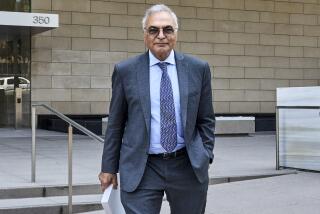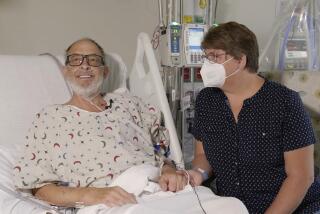Transplant Pioneer Urging That Artificial Heart Operations Resume : Medicine: A shortage of human hearts has again raised the issue of artificial hearts. However, the inventor of the most successful artificial heart argues that more research is needed.
TUCSON â In the three years since the last of the recipients of permanent artificial hearts died, the man-made blood pumps have been used only to keep patients alive until they could get a human heart transplant.
William J. Schroeder, 52, the second of five permanent artificial heart recipients, was the longest to live. He died on Aug. 7, 1986, of a stroke, 620 days after the operation.
Now, with a shortage of human heart donors, a pioneer in the transplant field says itâs time to resume implanting permanent artificial hearts, despite their shortcomings.
But the inventor of the most successful artificial heart to date disagrees, saying research efforts should be concentrated on developing a better pump.
And the surgeon most noted for implanting permanent artificial hearts has indicated little interest in resuming the work.
Nonetheless, Dr. Jack G. Copeland says the time has come to try again.
Copeland in 1985 became the first surgeon to use an artificial heart successfully as a temporary bridge to transplantation of a human heart. He says that despite its shortcomings, he has now changed his thinking about permanent implantation of the primary artificial heart now in use, the air-driven Symbion J-7, formerly known as the Jarvik-7.
One of those shortcomings is that the recipient is tethered through the abdominal wall to a pneumatic drive unit weighing about 300 pounds.
In a recent interview, Copeland said the device should be used for patients with end-stage heart disease who do not qualify for transplants because of their age or other health problems.
âI think in small terms about individual lives, one at a time, and why is somebody whoâs dying of heart disease any less valuable to us than somebody who has an aortic valve replacement or a coronary bypass?â says Copeland, who heads the heart-transplant program at the University of Arizona.
âI know thereâs something I can do for him. I just donât have the money, I donât have the support, I donât have somebody who says, âOK, Dr. Copeland, we give you approval for so many cases.â â
The biggest obstacles to anyone resuming implanting artificial hearts, he says, are money, the pressures of life in a fishbowl and the publicâs inability to view such procedures as experimental and âallow us to fail.â
The International Society for Heart Transplantation says 2,650 transplants were performed worldwide last year, including 1,630 in the United States. There were 1,441 in this country in 1987.
Experts say the number of donor hearts is reaching a plateau, though surveys have suggested that from 20,000 to 75,000 Americans could benefit annually if the supply were available.
Copeland believes the problems that plagued long-term recipients of artificial hearts, including infection, bleeding, strokes and clotting, can be solved and patients could be released to live in an apartment within about three weeks after surgery.
âIf I could get somebody to come up with enough bucks to do it, I would do it,â he says.
âI think that heâs perfectly justified to do that,â says Dr. Robert Jarvik, inventor of the Jarvik-7 and Jarvik-7-70 artificial hearts.
But because of the expense of artificial heart implantation and care, as well as their lack of mobility, Jarvik says itâs unlikely the currently designed pump will be pursued for permanent use.
âIf Dr. Copeland has resources and the availability to work on it, thatâs fine, itâs ethically justified, he can help some people,â Jarvik says. âBut I think in general most people want to work on electric-powered systems.â
Copeland concurs, but argues that until a better, internally powered device is developed, tested and available, lives can be prolonged by permanently implanting the current devices.
âI think we agree,â says Gerson Rosenberg, assistant chief for the Division of Artificial Organs at Pennsylvania State Universityâs Hershey Medical Center. Dr. William Pierce, the director, designed the Penn State artificial heart.






